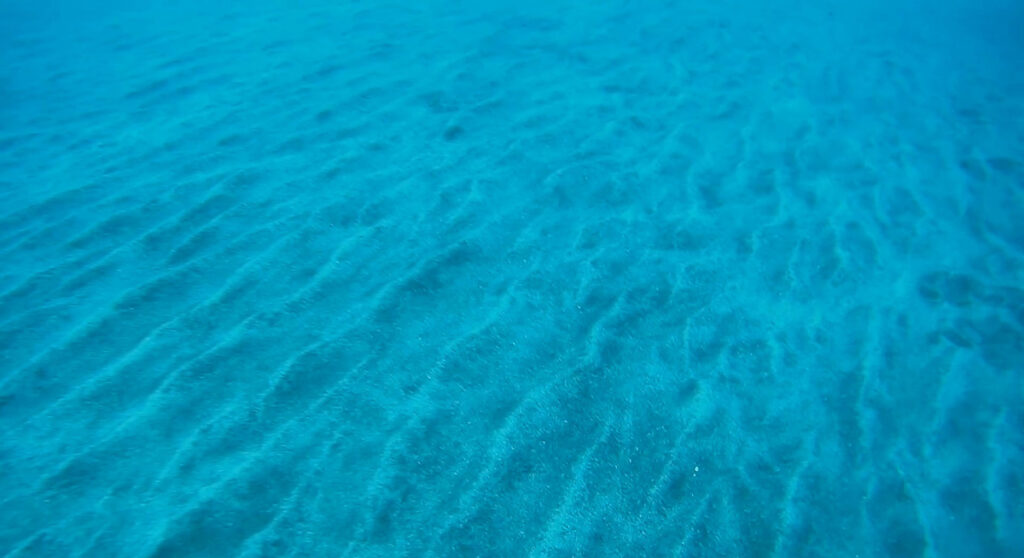After two research cruises to the Azores, scientists with the PLATMAR research project were loaded with data. They had collected a variety of information with multibeam bathymetry and seismic reflection, as well as video and images of the seabed. Importantly, the researchers also took measurements of the area’s sediment type and grain size, which provided a unique opportunity to test sediment transport in the Azores, a Portuguese archipelago in the North Atlantic where sand plays a critical role in fisheries, tourism, and building infrastructure.
“Threshold of motion—if you go into the sedimentological literature—comes into everything, but as far as I can see, nobody tests it in the field.”
To date, marine geoscientists rely on a set of equations to estimate the threshold of sediment motion—defined as the amount of stress exerted on the seabed (from external factors like currents and waves) that forces the sand to move. The equations are based on lab experiments using a flat surface and spherical quartz crystals. However, the seabed around the Azores and many other coastal areas is rocky and contains sediment made of crushed-up shells with many shapes and sizes.
It’s been unclear how well the threshold of motion applies in the real world, including the Azores. But according to Neil Mitchell, a marine Earth scientist at the University of Manchester, “it’s quite a fundamental number.…Threshold of motion—if you go into the sedimentological literature—comes into everything, but as far as I can see, nobody tests it in the field.”
In a new study published in Sedimentology, Mitchell and his colleagues compared observations of the seabed around Santa Maria Island in the Azores with modeling estimates of the region’s sediment transport. “Comparing the two, we found that they didn’t match particularly well,” said Mitchell.
Predictions Versus Reality
The researchers started their comparison by calculating the threshold of motion using the sediment grain sizes they collected from 112 sites around Santa Maria. Then they used a computational model to estimate the stress on the seabed caused by waves over 3 months of winter. “From that, you can predict whether the sediment should be moved or not,” Mitchell said.

The model predicted that sand on the whole shelf should have eroded, but that prediction was contrary to several pieces of observational data from the research cruise. Photographs of the seabed revealed evidence of motion on Santa Maria’s inner shelf, but on its outer shelf, the wavelengths of the ripples in the sand had a much larger amplitude, indicative of sediment that had been motionless for a while.
In addition, the grains of sediment were small in shallow waters but larger in deeper waters. Larger sediments indicate lack of motion because sediment movement breaks down the grains into smaller, more uniform shapes. Boomer seismic data, which can measure sediment layers within the seafloor, also supported evidence of unmoving sediment. The data showed a pattern of sediment deposition, not transport, midshelf.
Through trial and error, the researchers determined that if they multiplied the threshold of motion by a factor of 2–3, the model’s predictions and the field observations started to converge. Mitchell suggested the error is likely due to overestimating the wave-induced stress and underestimating the threshold of motion.
“The formulas that are used for calculating transport of sediments do not really apply to these carbonate sediments.”
“What we learned is that these formulas that are used for calculating transport of sediments do not really apply to these carbonate sediments,” concluded Rui Quartau, a marine geologist at Instituto Hidrográfico in Lisbon and lead investigator with PLATMAR. He added that stress caused by waves is likely overestimated because the seabed around Santa Maria has rocky outcrops, protecting sediment from being moved by waves.
“The idea of subsurface structure impacting and limiting the amount of wave-induced stress makes sense because if a wave hits that structure, it will have a dampening effect,” said Shahin Dashtgard, a sedimentologist at Simon Fraser University in Canada who was not involved in the study. “The key thing is this is a first step. It’s not something that people have talked about before,” he added, referring to the application of a correction factor to the threshold of motion prediction.
Dashtgard suggested more testing is required to accurately estimate correction factors for other coastal areas. Because threshold of motion predictions are used to fill in the gaps where sediment measuring instruments fall short, a deeper understanding of the margin of error in the calculations has a staggering number of implications for activities including fisheries, offshore wind projects, submarine oil pipelines, telecommunication cables, and sand dredging for construction.
—Andrew Chapman (@Andrew7Chapman), Science Writer

